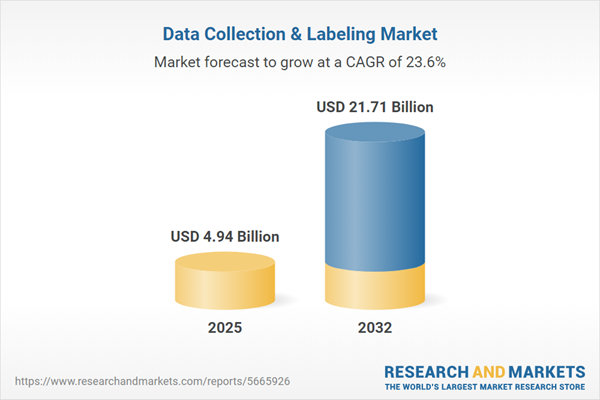Speak directly to the analyst to clarify any post sales queries you may have.
The Data Collection & Labeling Market is evolving as organizations prioritize automation and robust data governance to enhance compliance, streamline digital processes, and support risk-aware modernization efforts. Senior leaders are adapting to increased regulatory demands with scalable, structured labeling solutions to sustain business continuity and agility.
Market Snapshot: Data Collection & Labeling Market Analysis
The global Data Collection & Labeling Market is demonstrating strong growth, currently valued at USD 3.99 billion and expected to reach USD 4.94 billion by 2025 and USD 21.71 billion by 2032, reflecting a 23.56% compound annual growth rate. Intensified investment in automation technologies, rigorous compliance frameworks, and improved workflow management are reinforcing digital transformation. Enterprises are building IT environments that align with changing regulatory standards, enabling greater resilience and adaptability in competitive markets where access to high-quality labeled data underpins operational efficiency and readiness for future challenges.
Scope & Segmentation of the Data Collection & Labeling Market
- Component: Solutions include networking hardware, advanced storage systems, robust servers, middleware, managed services, software tools, comprehensive security, and technical support. These components collectively ensure reliable and consistent data operations.
- Application: Key use cases span asset tracking, real-time system monitoring, predictive analytics for maintenance, and supply chain optimization, supporting automated labeling and process efficiency across core business functions.
- End User Industry: Sectors such as energy, healthcare, manufacturing, logistics, utilities, automotive, electronics, aerospace, food, and beverage are leveraging structured data labeling to strengthen transparency, safeguard operations, and meet sector-specific compliance objectives.
- Deployment Model: Organizations deploy cloud-based or on-premises solutions, selecting models aligned with compliance, data sovereignty, and security needs, with flexibility for regional policy differences.
- Organization Size: Solutions are tailored for small businesses, mid-market enterprises, and large organizations. Scalability addresses diverse resource requirements as companies grow or operational needs shift.
- Distribution Channel: Technologies are accessible via online platforms and direct procurement, enabling companies to source solutions based on their preferred buying process and regional infrastructure.
- Geographic Coverage: The market spans the Americas, Europe, Middle East, Africa, and Asia-Pacific. North America and Europe reflect advanced solution adoption, while Asia-Pacific markets, particularly China, India, Japan, and Australia, accelerate digital modernization to align with industry regulations.
- Companies Profiled: Leading providers, including Appen Limited, TELUS Digital, Amazon Web Services, Scale AI, CloudFactory, iMerit Systems, Labelbox, and Alegion, are addressing industry-specific scalability and compliance needs with adaptive, sector-focused offerings.
Key Takeaways for Senior Decision-Makers
- Enterprises adopting synthetic data generation and federated learning benefit from efficient, scalable labeling for complex datasets, enhancing risk and compliance management across dispersed operations.
- Stronger regulatory oversight is prompting organizations to implement robust governance strategies that mitigate risk while maintaining operational flexibility in global environments.
- Hybrid deployment models deliver an effective balance between security and scalability, allowing organizations to expand advanced data-driven processes in varied operational backdrops.
- Process automation secures continuous performance, supporting business continuity and adaptation to new compliance standards without compromising workflow efficiency.
- Collaboration with technology and cloud service leaders bolsters integration, equipping enterprises to respond to evolving market requirements and ensuring competitive adaptability.
- Regional investments in automation are driving new adoption curves, with businesses placing greater emphasis on readiness and flexibility as regulatory expectations rise.
Tariff Impact on Supply Chains and Strategies
Adjustments to U.S. tariff policies have introduced cost and procurement pressures for data management hardware and software. In response, enterprises are diversifying suppliers, enhancing compliance processes, and refining procurement strategies to uphold supply chain resilience. These adjustments allow organizations to adapt to shifting international regulations while maintaining operational consistency.
Methodology & Data Sources
This analysis synthesizes insights from executive interviews, practitioner surveys, benchmarking with peers, and systematic regulatory reviews. Independent third-party validation and peer checks underpin the objectivity of the findings, supporting risk-informed decision-making and confident compliance management.
Why This Report Matters for Your Strategic Planning
- Provides current market intelligence to help leadership guide investments in automation and compliance, ensuring operational models can adapt to change.
- Offers clear insights that streamline digital transformation and support rapid responses to new regulatory and market conditions.
- Enables informed decisions as organizations build robust, scalable IT infrastructures to strengthen risk management across diverse markets and sectors.
Conclusion
Ongoing advancements in automation and compliance tools are essential for strengthening operational resilience. Enterprises adopting flexible data management approaches will be best positioned to manage regulatory shifts and drive successful business transformation.
Additional Product Information:
- Purchase of this report includes 1 year online access with quarterly updates.
- This report can be updated on request. Please contact our Customer Experience team using the Ask a Question widget on our website.
Table of Contents
3. Executive Summary
4. Market Overview
7. Cumulative Impact of Artificial Intelligence 2025
Companies Mentioned
The companies profiled in this Data Collection & Labeling market report include:- Appen Limited
- TELUS Digital by TELUS Communications Inc.
- Amazon Web Services, Inc.
- Scale AI, Inc.
- CloudFactory Limited
- iMerit Systems
- Labelbox, Inc.
- Alegion by SanctifAI Inc
Table Information
| Report Attribute | Details |
|---|---|
| No. of Pages | 184 |
| Published | November 2025 |
| Forecast Period | 2025 - 2032 |
| Estimated Market Value ( USD | $ 4.94 Billion |
| Forecasted Market Value ( USD | $ 21.71 Billion |
| Compound Annual Growth Rate | 23.5% |
| Regions Covered | Global |
| No. of Companies Mentioned | 9 |









